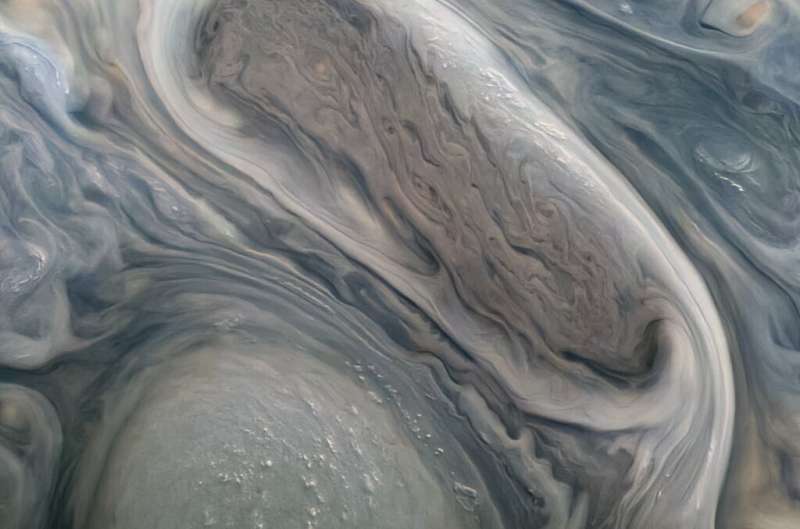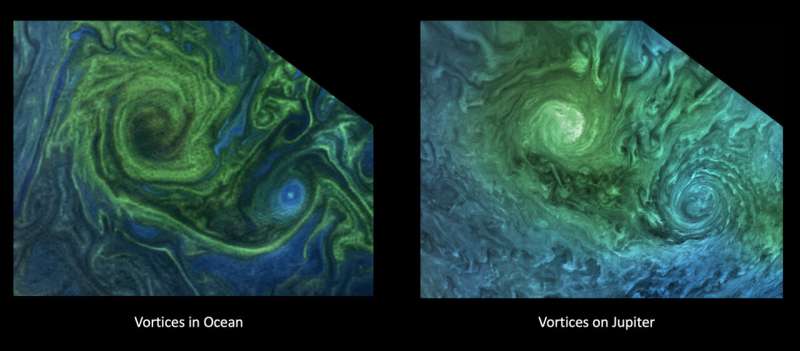Ashley Strickland
CNNDigital
Saturday, December 18, 2021

This image taken by the Juno mission shows two of Jupiter's large rotating storms, captured November 29. (Kevin M. Gill CC BY/MSSS/SwR/JPL-Caltech/NASA/CNN)
The largest planet in our solar system appears to look more and more like a work of art. It's full of surprises -- and so are its moons.
The NASA Juno mission, which began orbiting Jupiter in July 2016, just recently made its 38th close flyby of the gas giant. The mission was extended earlier this year, adding on a flyby of Jupiter's moon Ganymede in June.
The data and images from these flybys is rewriting everything we know about Jupiter, said Scott Bolton, Juno principal investigator at the Southwest Research Institute in San Antonio, during a briefing at the American Geophysical Union Fall Meeting in New Orleans on Friday.
There, Bolton revealed 50 seconds of sound created when Juno flew by Ganymede over the summer.The clip of the moon's audio was created by electric and magnetic radio waves produced by the planet's magnetic field and picked up by the spacecraft's Waves instrument, designed to detect these waves. The sounds are like a trippy space age soundtrack.
"This soundtrack is just wild enough to make you feel as if you were riding along as Juno sails past Ganymede for the first time in more than two decades," Bolton said. "If you listen closely, you can hear the abrupt change to higher frequencies around the midpoint of the recording, which represents entry into a different region in Ganymede's magnetosphere."
The Juno team continues to analyze the data from the Ganymede flyby. At the time, Juno was about 645 miles (1,038 kilometres) from the moon's surface and zipping by at 41,600 mph (67,000 kilometres per hour).
"It is possible the change in the frequency shortly after closest approach is due to passing from the nightside to the dayside of Ganymede," said William Kurth, lead co-investigator of the Waves instrument, who is based at the University of Iowa in Iowa City, in a statement.
The team also shared stunning new images that resemble artistic views of Jupiter's swirling atmosphere.
"You can see how incredibly beautiful Jupiter is," Bolton said. "It's really an artist's palette. This is almost like a Van Gogh painting. You see these incredible vortices and swirling clouds of different colors."
These visually stunning images serve to help scientists better understand Jupiter and its many mysteries. Images of cyclones at Jupiter's poles intrigued Lia Siegelman, a scientist working with the Juno team who typically studies Earth's oceans. She saw similarities between Jupiter's atmospheric dynamics and vortices in Earth's oceans.
"When I saw the richness of the turbulence around the Jovian cyclones, with all the filaments and smaller eddies, it reminded me of the turbulence you see in the ocean around eddies," said Siegelman, a physical oceanographer and postdoctoral fellow at Scripps Institution of Oceanography at the University of California, San Diego, in a statement.
"These are especially evident in high-resolution satellite images of vortices in Earth's oceans that are revealed by plankton blooms that act as tracers of the flow."
MAPPING JUPITER'S MAGNETIC FIELD
Data from Juno is also helping scientists to map Jupiter's magnetic field, including the Great Blue Spot. This region is a magnetic anomaly located at Jupiter's equator -- not to be confused with the Great Red Spot, a centuries-long atmospheric storm south of the equator.
Since Juno's arrival at Jupiter, the team has witnessed a change in Jupiter's magnetic field. The Great Blue Spot is moving eastward about 2 inches (5.1 centimetres) per second and will complete a lap around the planet in 350 years.
Meanwhile, the Great Red Spot is moving westward and will cross that finish line much quicker, in about 4.5 years.
But the Great Blue Spot is being pulled apart by Jupiter's jet streams, which give it a striped appearance. This visual pattern tells scientists that these winds extend down much deeper into the planet's gaseous interior.
The map of Jupiter's magnetic field, generated by Juno data, also revealed that the planet's dynamo action, which creates the magnetic field from Jupiter's interior, originates from metallic hydrogen beneath a layer of "helium rain."
Juno was also able to take a look at the very faint ring of dust around Jupiter from inside the ring. This dust is actually created by two of the planet's small moons, named Metis and Adrastea. The observations allowed the researchers to see part of the Perseus constellation from a different planetary perspective.
"It is breathtaking that we can gaze at these familiar constellations from a spacecraft a half-billion miles away," said Heidi Becker, lead co-investigator of Juno's Stellar Reference Unit instrument at NASA's Jet Propulsion Laboratory in Pasadena, California, in a statement.
"But everything looks pretty much the same as when we appreciate them from our backyards here on Earth. It's an awe-inspiring reminder of how small we are and how much there is left to explore."
In the fall of 2022, Jupiter will fly by Jupiter's moon Europa, which will be visited by its own mission, the Europa Clipper, set to launch in 2024.
Europa intrigues scientists because a global ocean is located beneath its ice shell. Occasionally, plumes eject from holes in the ice out into space.
Europa Clipper could investigate this ocean by "tasting" and flying through the plumes -- and learn if life is possible on this ocean world.

Oceanographers are using their expertise of ocean eddies to study the turbulence at Jupiter's poles and the physical forces that drive its large cyclones. Compare this image of a phytoplankton bloom in the Norwegian Sea (left) with turbulent clouds in Jupiter's atmosphere (right).
Juno spacecraft 'hears' Jupiter's moon

Sounds from a Ganymede flyby, magnetic fields, and remarkable comparisons between Jupiter and Earth's oceans and atmospheres were discussed during a briefing today on NASA's Juno mission to Jupiter at the American Geophysical Union Fall Meeting in New Orleans.
Juno Principal Investigator Scott Bolton of the Southwest Research Institute in San Antonio has debuted a 50-second audio track generated from data collected during the mission's close flyby of the Jovian moon Ganymede on June 7, 2021. Juno's Waves instrument, which tunes in to electric and magnetic radio waves produced in Jupiter's magnetosphere, collected the data on those emissions. Their frequency was then shifted into the audio range to make the audio track.
"This soundtrack is just wild enough to make you feel as if you were riding along as Juno sails past Ganymede for the first time in more than two decades," said Bolton. "If you listen closely, you can hear the abrupt change to higher frequencies around the midpoint of the recording, which represents entry into a different region in Ganymede's magnetosphere."
Detailed analysis and modeling of the Waves data are ongoing. "It is possible the change in the frequency shortly after closest approach is due to passing from the nightside to the dayside of Ganymede," said William Kurth of the University of Iowa in Iowa City, lead co-investigator for the Waves investigation.
At the time of Juno's closest approach to Ganymede—during the mission's 34th trip around Jupiter—the spacecraft was within 645 miles (1,038 kilometers) of the moon's surface and traveling at a relative velocity of 41,600 mph (67,000 kph).
Magnetic Jupiter
Jack Connerney from NASA's Goddard Space Flight Center in Greenbelt, Maryland, is the lead investigator with Juno's magnetometer and is the mission's deputy principal investigator. His team has produced the most detailed map ever obtained of Jupiter's magnetic field.
Compiled from data collected from 32 orbits during Juno's prime mission, the map provides new insights into the gas giant's mysterious Great Blue Spot, a magnetic anomaly at the planet's equator. Juno data indicates that a change in the gas giant's magnetic field has occurred during the spacecraft's five years in orbit, and that the Great Blue Spot is drifting eastward at a speed of about 2 inches (4 centimeters) per second relative to the rest of Jupiter's interior, lapping the planet in about 350 years.
In contrast, the Great Red Spot—the long-lived atmospheric anticyclone just south of Jupiter's equator—is drifting westward at a relatively rapid clip, circling the planet in about four-and-a-half years.
In addition, the new map shows that Jupiter's zonal winds (jet streams that run east to west and west to east, giving Jupiter's its distinctive banded appearance) are pulling the Great Blue Spot apart. This means that the zonal winds measured on the surface of the planet reach deep into the planet's interior.
The new magnetic field map also allows Juno scientists to make comparisons with Earth's magnetic field. The data suggests to the team that dynamo action—the mechanism by which a celestial body generates a magnetic field—in Jupiter's interior occurs in metallic hydrogen, beneath a layer expressing "helium rain."
Data Juno collects during its extended mission may further unravel the mysteries of the dynamo effect not only at Jupiter but those of other planets, including Earth.

Earth's Oceans, Jupiter's Atmosphere
Lia Siegelman, a physical oceanographer and postdoctoral fellow at Scripps Institution of Oceanography at the University of California, San Diego, decided to study the dynamics of Jupiter's atmosphere after noticing that the cyclones at Jupiter's pole appear to share similarities with ocean vortices she studied during her time as a doctoral student.
"When I saw the richness of the turbulence around the Jovian cyclones, with all the filaments and smaller eddies, it reminded me of the turbulence you see in the ocean around eddies," said Siegelman. "These are especially evident in high-resolution satellite images of vortices in Earth's oceans that are revealed by plankton blooms that act as tracers of the flow."
The simplified model of Jupiter's pole shows that geometric patterns of vortices, like those observed on Jupiter, spontaneously emerge, and survive forever. This means that the basic geometrical configuration of the planet allows these intriguing structures to form.
Although Jupiter's energy system is on a scale much larger than Earth's, understanding the dynamics of the Jovian atmosphere could help us understand the physical mechanisms at play on our own planet.
Arming Perseus
The Juno team has also released its latest image of Jupiter's faint dust ring, taken from inside the ring looking out by the spacecraft's Stellar Reference Unit navigation camera. The brightest of the thin bands and neighboring dark regions scene in the image are linked to dust generated by two of Jupiter's small moons, Metis and Adrastea. The image also captures the arm of the constellation Perseus.
"It is breathtaking that we can gaze at these familiar constellations from a spacecraft a half-billion miles away," said Heidi Becker, lead co-investigator of Juno's Stellar Reference Unit instrument at NASA's Jet Propulsion Laboratory in Pasadena. "But everything looks pretty much the same as when we appreciate them from our backyards here on Earth. It's an awe-inspiring reminder of how small we are and how much there is left to explore."
Spacecraft buzzes Jupiter's mega moon, 1st close-up in years
No comments:
Post a Comment